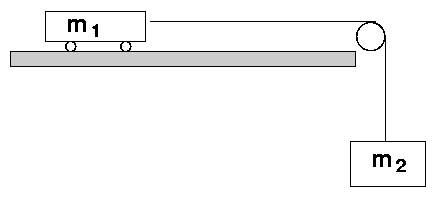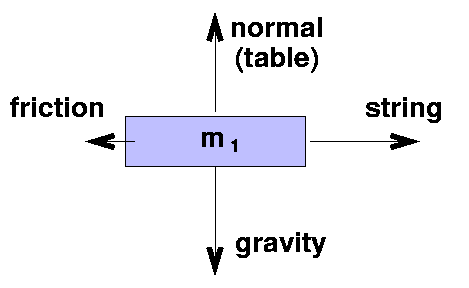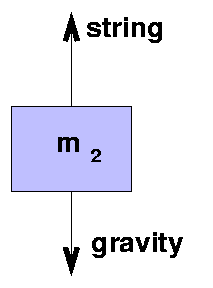
 Copyright © Michael Richmond.
This work is licensed under a Creative Commons License.
Copyright © Michael Richmond.
This work is licensed under a Creative Commons License.
You have seen before this version of a modified Atwood's machine:

If we hold the cart motionless, then release it, it will slide towards the pulley as the weight falls downwards. In the past, we assumed that the cart rolled and the pulley rotated without friction. But in real life, there will be some friction which acts to slow the cart down. Can you figure out the acceleration of the cart -- which is the same as that of the weight -- in the presence of friction?
Let's make free-body diagrams of the cart and the weight separately.

Force x y
-----------------------------------
string +T 0
normal (table) 0 +N
gravity 0 -m1*g
friction -f 0
-----------------------------------
total m1*ax m1*ay
-----------------------------------
If we add up the forces in each direction and use Newton's Second Law, we get
T - f = m1*ax (Eq 1)
N - m1*g = m1*ay = 0 ---> N = m1*g
We want to know ax for the cart, but we still have two unknowns and only one equation. Rats. Let's look at the hanging weight.

Force x y
-----------------------------------
string 0 +T
gravity 0 -m2*g
-----------------------------------
total m2*ax m2*ay
-----------------------------------
For this object, we find Newton's Second Law says:
0 - 0 = m1*ax = 0
T - m2*g = m2*ay (Eq 2)
Putting together Eq 1 (from the cart) and Eq 2 (from the weight), we find
T - m2*g = m2*ay (Eq 2)
T - f = m1*ax (Eq 1)
Because the two objects are tied together with the same piece of string, the tension T is the same in both. In addition, the magnitude of the two accelerations must be the same. However, note that if the cart goes to the right (in +x direction, so accel ax is positive), then the weight must drop downwards (in -y direction, so accel ay is negative). This means that ax = -ay. Let's replace ay by -ax and solve for the acceleration of the cart.
T - m2*g = m2*(-ax) (Eq 2)
T - f = m1*ax (Eq 1)
Can you solve for this acceleration ax?
(ready?)
m2 * g f
ax = ------- - -------
m1 + m2 m1 + m2
How can you tell if the friction in this experiment is signficantly different from zero? Note that the equation for acceleration has two parts: if we keep the total mass (m1 + m2) constant, and just change the hanging weight, then
m2 * g f
a = ------- - -------
m1 + m2 m1 + m2
this part this part
changes remains
with m2 the same
It becomes even more clear if we re-write it like this:
[ g ] f
a = [ ------- ] * m2 - -------
[ m1 + m2 ] m1 + m2
This looks like the equation of a line:
y = (slope) * x + y-intercept
So, if you can measure the acceleration for several different values of hanging mass (while keeping total mass constant), and graph the acceleration versus the hanging mass, you can use the y-intercept to determine the friction ... AND whether it differs from zero.
The most important value you must derive is the size of the friction force, plus its uncertainty. Is it significantly different from zero?
 Copyright © Michael Richmond.
This work is licensed under a Creative Commons License.
Copyright © Michael Richmond.
This work is licensed under a Creative Commons License.